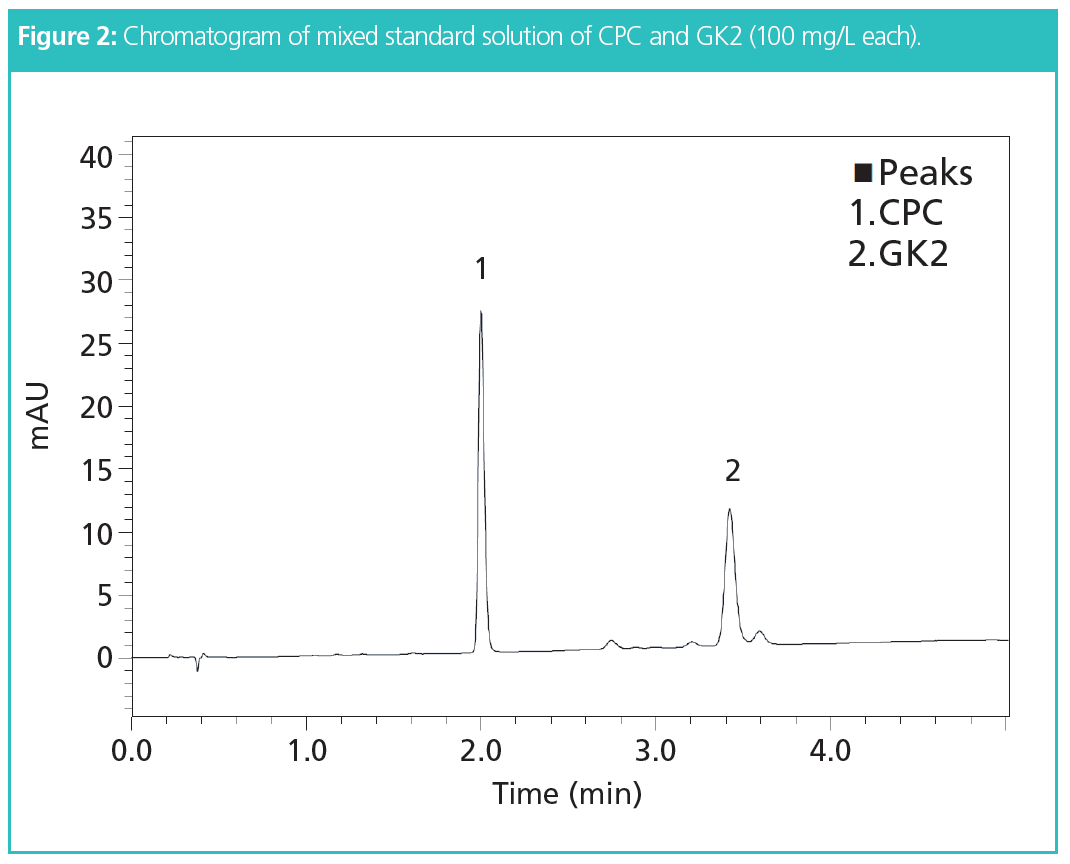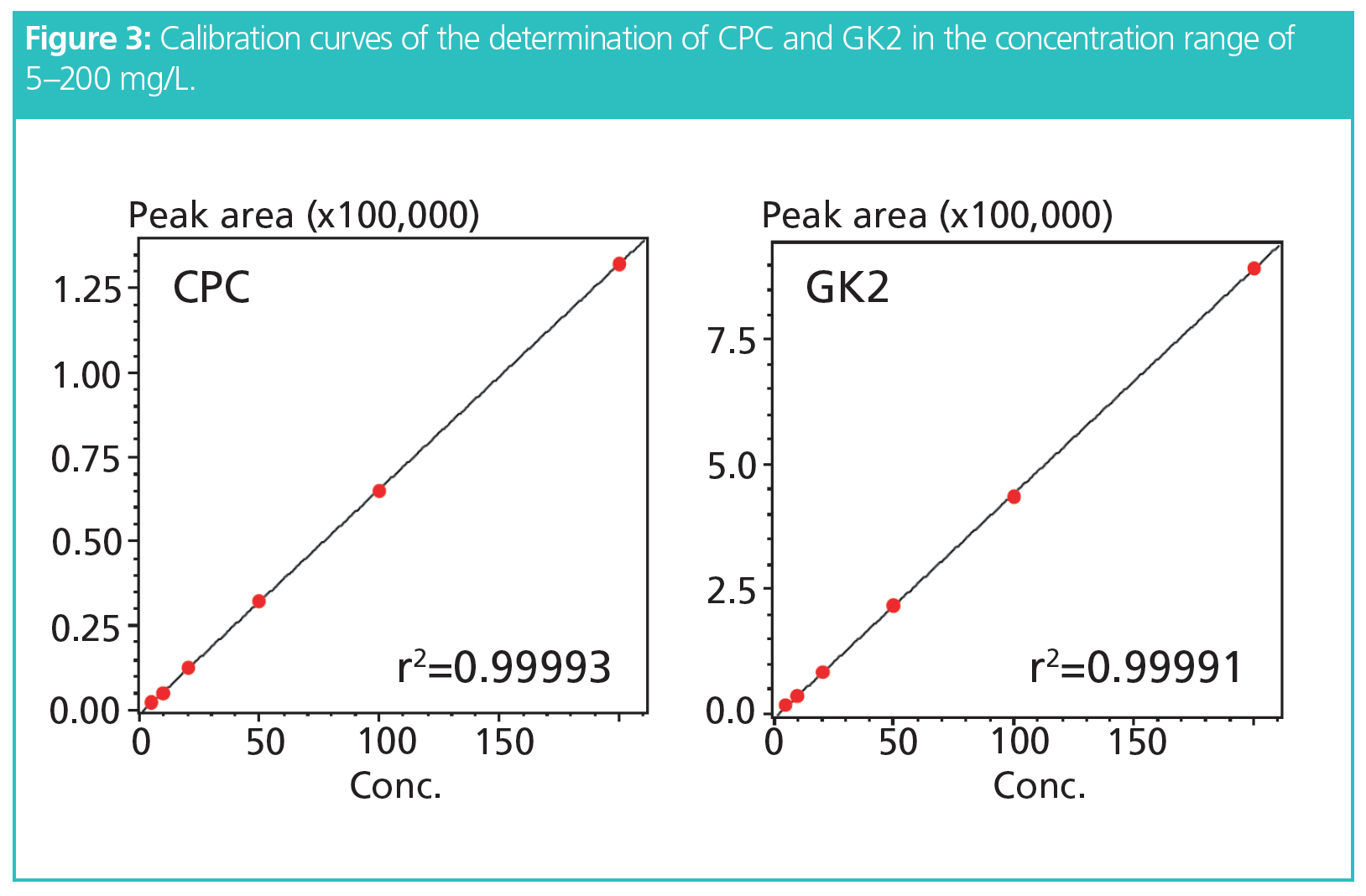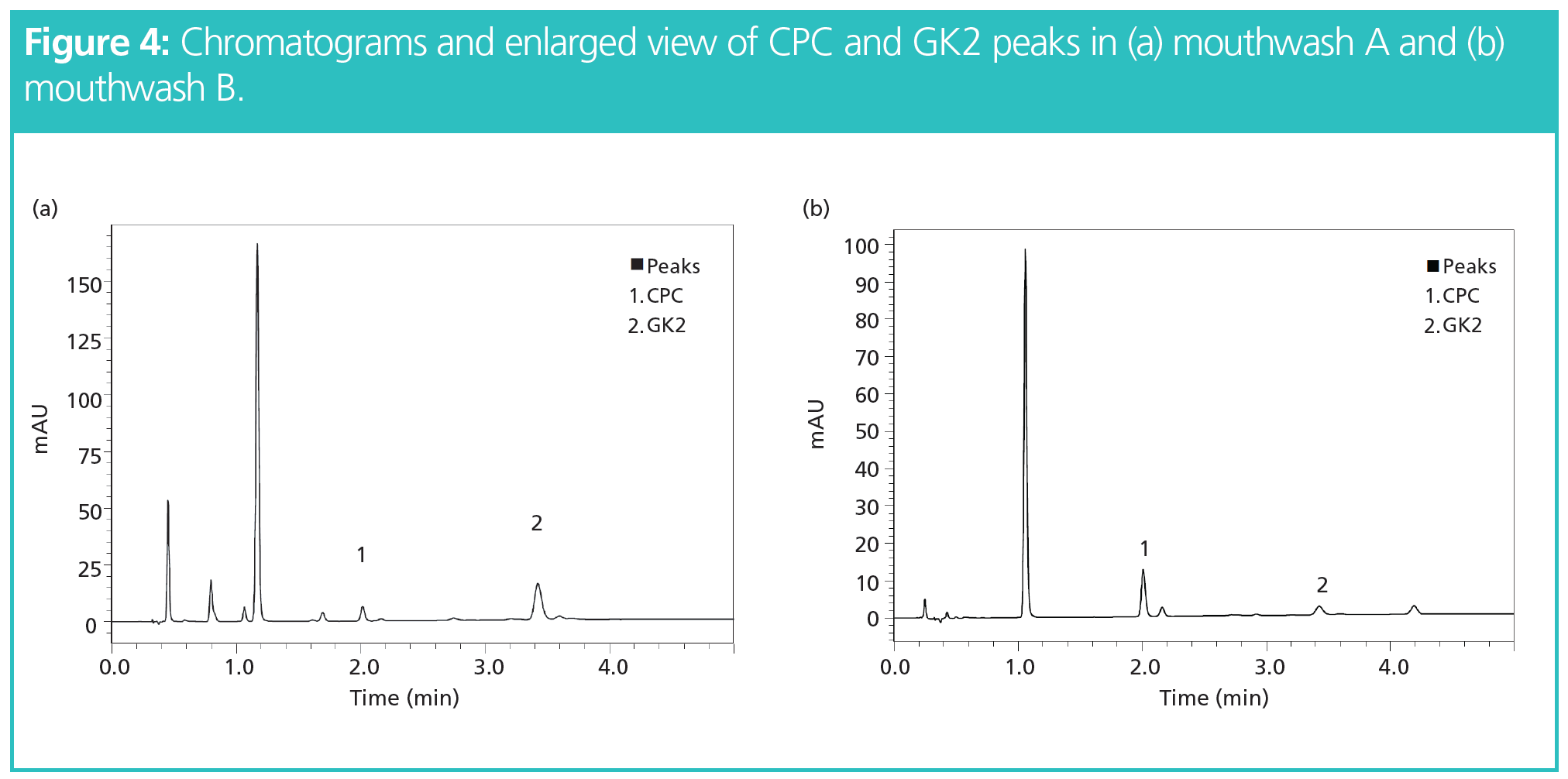UHPLC Analysis of Active Ingredients in Oral Rinse Solution
Commercial oral care products contain multiple active ingredients, which are generally analyzed by high performance liquid chromatography (HPLC). The quaternary ammonium salt cetylpyridinium chloride (CPC) interacts with residual silanol groups on ordinary C18 columns, resulting in adsorption and severe peak tailing. While adsorption of target compounds can be suppressed using ion-pairing reagents, use of additives in the mobile phase is not always desirable. This article introduces a high-speed and simultaneous analysis of common active ingredients used in mouthwashes, namely CPC and dipotassium glycyrrhizinate (GK2), on a C18 column specifically designed for analysis of basic compounds. Interaction with residual silanol groups was sufficiently suppressed, and good peak shape was obtained without the addition of an ion-pairing reagent.
Cetylpyridinium chloride (CPC) and dipotassium glycyrrhizinate (GK2) are common active ingredients in commercial oral care products because they exhibit bactericidal and anti-inflammatory properties (1,2). CPC has also been shown to possess antiviral activity and has recently been proposed to reduce infectivity of airborne-transmitted viruses, including SARS-COV-2 variants (3). Determination of active ingredients in oral rinse solutions or spray during production and quality control is generally carried out using high performance liquid chromatography (HPLC) analysis. The quaternary ammonium salt CPC carries a positive charge (Figure 1) and is therefore prone to peak tailing due to adsorption to negatively charged residual silanol groups remaining on the surface of the silica gel packing material of conventional C18 columns (1,2). “End‑capping”, meaning replacement of residual silanol with trimethylsilyl groups to reduce unwanted secondary interactions, has become common practice. However, it is impossible to react with all available silanol groups, and, depending on the target compound, peak tailing may occur, despite using a stationary phase that has been exhaustively end-capped (4). Sometimes ion-pairing reagents are used to suppress adsorption of the target analytes. However, these can permanently bind to the stationary phase surface, altering its retention characteristics irrevocably. This article introduces a high‑speed method capable of simultaneously analyzing CPC and GK2 using a C18 column that was specifically designed for the analysis of basic compounds, where the effect of CPC interacting with residual silanol groups can be efficiently suppressed, and good peak shape obtained, without the addition of an ion-pairing reagent.

Experimental
Mixed standard solutions of the analytes of interest were prepared in the concentration range of 5–200 mg/L and analyzed using the conditions listed below. Figure 2 shows a typical chromatogram of the separation obtained using the 100 mg/L mixed standard solution.

Analytical Conditions: System: Nexera XR UHPLC (Shimadzu); column: 75 mm × 3.0 mm, 2.2-µm Shim-pack Arata C18 (Shimadzu); flow rate: 1.0 mL/min; mobile phase: A) 0.1% formic acid in water, B) 0.1% formic acid in acetonitrile; time program: 40%B (0 min) " 50%B (4.00–4.50 min) " 40%B (4.51–7.00 min); column temp.: 40 ˚C; injection volume: 1 µL; detection (PDA): λ = 254 nm.
Discussion
Repeatability of the method was determined based on retention time and peak area from six successive analyses of a 10 mg/L mixed standard solution. Linearity was evaluated by producing calibration curves using standard solutions within a concentration range of 5–200 mg/L of CPC and GK2. With correlation coefficients of r2 = 0.9999 or greater, and variation of ≤ 0.6% in retention time and peak area for both analytes, good linearity and repeatability of the assay was established. Detailed results can be found in Table 1 and Figure 3, respectively.


Sample Analysis: CPC and GK2 in Oral Rinse Solution: Samples of two commercially available mouthwashes were analyzed. Sample preparation consisted of a 10-fold dilution using ultrapure water and filtration through 0.2 μm membrane filters. Chromatograms obtained from analysis of these real-life samples are displayed in Figure 4(a). The diluted samples A and B were found to contain 23.1 mg/L of CPC and 143.6 mg/L of GK2, and 44.7 mg/L of CPC and 22.4 mg/L GK2, respectively.

In addition to peak identification by retention time, qualitative data were confirmed based on the UV spectra recorded using the photodiode array (PDA) detector.
Figure 5 shows the comparison of spectral data obtained from CPC and GK2 standard solutions to PDA data from peaks 1 and 2 in sample A. The respective UV spectra were normalized for comparison. Both peaks could be clearly identified as CPC (1) and GK2 (2) according to the maximum absorption wavelengths at 212 nm and 258 nm for CPC, and 250 nm for GK2.

Analysis of highly basic compounds, such as quaternary ammonium salts, is challenging on traditional HPLC columns. Using this dedicated C18 phase prevented any secondary interaction of the positive charge with residual silanol groups. Good peak shape in a fast, gradient method for sensitive detection of both analytes of interest was achieved without use of an ion-pairing reagent.
Conclusion
A fast and simple ultrahigh-pressure liquid chromatography (UHPLC) method for simultaneous analysis of active ingredients CPC and GK2 in mouthwash was developed. Good peak shape with no tailing was obtained using this dedicated C18 column, even for the quaternary ammonium compound CPC. Results were obtained without the addition of an ion‑pairing reagent, which could alter the stationary phase and result in extended retention of the analytes. Elution of both target compounds could be achieved within 4 min with good repeatability and proven linearity within the range of 5–200 mg/L.
References
- N. Iwata, Shimadzu Corporation Application News No. 01-00116A-EN, Shimadzu Corporation, December 2021
- K. Nasila, K.V. Shijith, K.K. Mohammed Shihab, and C. Ramya, Int. J. Res. Rev. 8(4), 439–445 (2021). https://doi.org/10.52403/ijrr.20210453
- J. Muñoz-Basagoiti, D. Perez-Zsolt, R. León, V. Blanc, D. Raïch-Regué, M. Cano‑Sarabia, B. Trinité, E. Pradenas, J. Blanco, J. Gispert, B. Clotet, and N. Izquierdo‑Useros, J. Dent. Res. 100(11), 1265–1272 (2021). https://journals.sagepub.com/doi/10.1177/00220345211029269
- B.A. Bidlingmeyer, J. Chromatogr. Sci. 40, 417–418 (2002). https://doi.org/10.1093/chromsci/40.7.417
Gesa Johanna Schad graduated with a diploma in chemical engineering from the Technical University NTA in Isny, Germany, in 2004 and as a master of science in pharmaceutical analysis from the University of Strathclyde in Glasgow, UK, in 2005. She worked until 2006 as a consultant in HPLC method development and validation in an analytical laboratory of the FAO/IAEA in Vienna, Austria. She gained her doctorate for research in pharmaceutical sciences at the University of Strathclyde in 2010 and was employed as an HPLC specialist in the R&D department at Hichrom Ltd in Reading, UK, from 2009. Since 2013, she has worked as a HPLC product specialist and since 2015 as HPLC Product Manager in the analytical business unit of Shimadzu Europa in Duisburg, Germany.
Natsuki Iwata graduated with a diploma in chemistry and materials technology from Kyoto Institute of Technology in Kyoto, Japan, in 2010 and a MEng in chemistry and materials technology from the Graduate School of Science and Technology, Kyoto Institute of Technology, in 2012. She has worked as an HPLC product specialist in the global application development centre of Shimadzu Corporation in Kyoto, Japan, since 2012.

New Study Reviews Chromatography Methods for Flavonoid Analysis
April 21st 2025Flavonoids are widely used metabolites that carry out various functions in different industries, such as food and cosmetics. Detecting, separating, and quantifying them in fruit species can be a complicated process.
Analytical Challenges in Measuring Migration from Food Contact Materials
November 2nd 2015Food contact materials contain low molecular weight additives and processing aids which can migrate into foods leading to trace levels of contamination. Food safety is ensured through regulations, comprising compositional controls and migration limits, which present a significant analytical challenge to the food industry to ensure compliance and demonstrate due diligence. Of the various analytical approaches, LC-MS/MS has proved to be an essential tool in monitoring migration of target compounds into foods, and more sophisticated approaches such as LC-high resolution MS (Orbitrap) are being increasingly used for untargeted analysis to monitor non-intentionally added substances. This podcast will provide an overview to this area, illustrated with various applications showing current approaches being employed.

.png&w=3840&q=75)

.png&w=3840&q=75)



.png&w=3840&q=75)



.png&w=3840&q=75)













